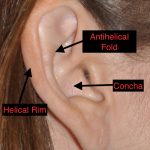The ears make up a small and often unnoticed part of the face. Since they sit way to the side of the face and are often obscured by hair, they make little impact on one’s facial appearance. Unless they have a congenital alteration of its complex cartilage structure which causes them to become visibly prominent. The most common cartilage deformity is that which causes the protruding ear.
There is a certain amount of distance between the ear and the side of the head which makes it either indiscriminate or very noticeable. Known as the auriculocephalic (ear to head) angle, it should generally be no greater than 30 degrees. When the ear sticks out more than that, it becomes a facial focal point. Known by a lot of unflattering names, dumbo ears and elephant ears to name a few, protruding ears can be a source of poor self-image and ridicule.


A good otoplasty result is one that does not trade-off one ear deformity for another. Overcorrection (setback too far) is known as the telephone ear deformity and looks like an ear plastered to the side of the head. Symmetry of the ear correction is relatively important even though both ears are not usually viewed at the same time. But patients will pay much more attention to their ears after surgery so intraoperative matching and attention to detail is important.
One aspect of otoplasty that is often overlooked is the earlobe. While it does not have any cartilage in it, it often will stick out too far with the rest of the ear as well. I frequently will set it back with the cartilage of the ear through a fishtail pattern skin excision on its back surface. This simple otoplasty maneuver can make a good ear result look even better. The helical rim of the ear should be seen as flowing from the top down to the bottom of the earlobe without outward deviation.
Otoplasty surgery requires an appreciation of the cartilage problem and matching it with the correct cartilage manipulation techniques. Done through an incision on the back of the ear, it is a simple but eloquent outpatient procedure that produces immediate and dramatic results. In some protruding ear problems that are not severe, the surgery can be performed in the office under local anesthesia.
Dr. Barry Eppley
Indianapolis, Indiana



